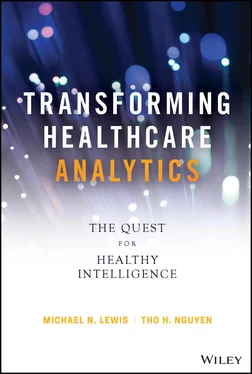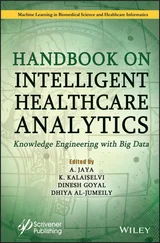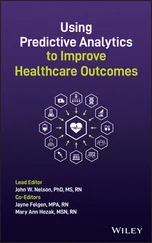If you are a healthcare professional concerned about applying data and analytics to improve your organization, this book will give you valuable insights. The advice and framework will help you organize, recruit, train, and develop the data analytics capability you need.
Healthcare needs to become more data-driven, more analytic. This book will show you how.
1 1 James is CEO and Principal Consultant, Decision Management Solutions and a faculty member of the International Institute for Analytics. He is the author of Digital Decisioning: Using Decision Management to Deliver Business Impact from Artificial Intelligence (MK Press, 2019) and Real-World Decision Modeling with DMN with Jan Purchase (MK Press, 2017). He also wrote Decision Management Systems: A Practical Guide to Using Business Rules and Predictive Analytics (IBM Press, 2012) and Smart (Enough) Systems (Prentice Hall, 2007) with Neil Raden. James is an active consultant, educator, speaker, and writer working with companies all over the world. He is based in Palo Alto, CA and can be reached at james@decisionmanagementsolutions.com.
“Without data, you're just another person with an opinion.”
— W. Edwards Deming
While there have been many improvements and changes in healthcare, Mike and I strongly believe there is still a lot to do and we want to share with you our journey to make healthcare better one patient at a time. Our motivation for this book is to share with our valued readers real-world, personal experiences and to show how technology coupled with people and process is paving the way toward the adoption of the digital transformation in healthcare. Digital transformation also makes a strong case for how healthcare organizations can do so much better because of the innovative analytical practices that we have readily available today but they are not implemented or being considered in many instances.
Whether you realize it or not, healthcare affects everyone – young and old. When you, Mike, or I were kids, healthcare was not a topic of concern. Most of us had parents or guardians to oversee our healthcare. Personally, as I have gotten older and more mature mentally and physically, healthcare has become a necessity with more regular visits to the doctor or hospital. When we become guardians and parents ourselves, we have others to think about, whether it is looking after our own kids, taking care of an elderly family member or our own parents, or even fostering children. As a new parent, healthcare is definitely a priority for my wife and kids, not only having access to healthcare but also the quality of care that we seek when needed. Healthcare affects all of us one way or another throughout our life cycle, from birth, toddler, adolescent, adult to end of life.
Healthcare affected me very personally about a year ago when my wife was misdiagnosed or missed diagnosed due to lack of data and empathy in the plan of care. It was a brisk winter morning in February when it all started when my wife complained about some back pains and stomach discomfort. My wife and I had our daily routines where I was working in my home office and she was getting our daughter ready for school. That afternoon, my wife's agonizing back pains and stomach discomfort escalated to a level beyond tolerable. Having had these symptoms in the past, she had been taking over-the-counter medications to see if they would go away. Unfortunately, they didn't and this time the pain became so much worse. Since our family doctor's office was closed due to it being after business hours, urgent care was our best option. It was late afternoon on Valentine's day and it was a day that we will never forget. Once we arrived at the urgent care, we filled out forms about my wife and symptoms that she was experiencing. The nurse asked her repetitive questions and took notes at the same time. We provided our insurance coverage details and were asked to wait. Because it was Valentine's day, the urgent care waiting room was nearly empty and the doctor was able to see us pretty quickly. The urgent care doctor asked my wife the same questions that the nurse had asked, then examined my wife but could not pinpoint the cause and a cure for the pain. The urgent care office suggested that we go directly to a nearby hospital emergency room (ER) to get a better diagnosis of my wife's condition. The urgent care nurse said that all of my wife's visit and information would be transferred to the ER and they would know what was done at the urgent care since it is affiliated with the ER hospital. Upon arrival at the ER and at check-in, there were no records and no one was aware of our arrival, situation, and condition. Thus, the traumatic drama escalated and continued on Valentine's evening.
Because all the data that was collected at the urgent care office was not in the system at the ER hospital, my wife and I had to relate all the same information again. In the midst of severe pain, I responded to most of the questions on behalf of my wife. The most obvious data such as name, address, birth date, Social Security number, insurance numbers, and gender were needed and entered on a form again before we could be checked into the ER. At this point, I could see my wife's pain had worsened and asked why there were no records and information from the urgent care office which is affiliated with the ER hospital. I questioned the repetitive process and why we had to enter the same data on the forms when my wife is a patient at the hospital and had history at the facility for over five years. The response was “We needed the data and forms to admit your wife” and we had no choice but to abide at that moment in time. After a few hours of waiting, we finally saw a nurse who asked the same, repetitive questions from the forms that we had filled out and then documented my wife's symptoms. A few more hours of waiting and we finally saw an ER doctor. The ER doctor asked the same questions as the nurse did and we felt like a broken record repeating the same information for the fourth time. Finally, the ER doctor ordered blood tests, x-rays, and a magnetic resonance image (MRI). Each procedure was executed by a different personnel and department, so we had to wait even more in the hospital room in between each test. As you can imagine, hours passed waiting for results from each test and the pain continued.
Being helpless had to be the worst feeling – unable to do anything except sit and wait with my very young daughter, whom we had brought along, thinking that we would be home within a few hours. Having a two-year-old toddler in an ER at the peak of winter when colds and flus were highly contagious was nerve-racking and worrisome. The doctor finally visited our room to give us the diagnosis. Based on the results, the diagnosis was an infection and the doctor gave my wife some prescription medication to help with the pain and antibiotics for what was diagnosed to be a urinary tract infection (UTI). I vividly remember it was 4 a.m. the next day that my wife was released from the ER and we got to go home. We would never forget how we spent that year's Valentine's Day and were happy to head home. It was a blessing that there was a path to alleviating the pain for my wife.
A few weeks later, once the antibiotics were completely consumed, my wife was feeling better and we thought she was cured with no pain in the stomach and back. Regrettably, that was not the case as the back pain and stomach discomfort returned with a vengeance. Over a six-month time span, from February when the pain started to August when it was correctly diagnosed and my wife had an operation, we had multiple visits to our family doctor, specialists, and the ER. Each time we visited a clinician and the ER, my wife had a different diagnosis which the doctors were unsure how to treat and what to do about it. Each visit required more bloodwork, x-rays, and MRIs – all of which were captured in fragmented, siloed systems from each office and there was no clear path to a cure in sight. Each ER stay was one week long and I had to communicate the history and recent visits to each nurse, doctor, and specialist at each hospital. During this time, my wife had multiple procedures and operations at various hospitals within one healthcare system but much of the data and details were not related or communicated among nurses and doctors. In the middle of summer, we had our final procedure and it was to remove an infected gallbladder, an insertion and removal of two stents to isolate the gallstone and an extremely stubborn, oversized gallstone. What should have been a simple diagnosis to detect the gallstone and removal of the gallbladder dragged on for six months with extreme pain and agony. In addition, we had multiple hospital stays that were costly and stressful.
Читать дальше












